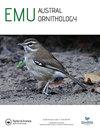在新西兰北部,南岛的斑牡蛎捕食者(Haematopus finschi)对受保护的贝类toheroa (papiies心室)的捕食影响
IF 1.1
4区 生物学
Q3 ORNITHOLOGY
引用次数: 0
摘要
在新西兰北部,有推测认为,一种正在恢复的滨鸟——南岛斑胸蛎鹬(Haematopus finschi)的捕食,导致了当地特有的冲浪蛤(Paphies osa)数量的持续下降。因此,公众一直要求捕杀这些受保护的鸟类,以保护和恢复这片土地。为了更好地为这些物种的管理和决策提供信息,我们开始了解捕牡蛎者捕食对新西兰Ripiro海滩上的toheroa的影响。本研究建立了河豚和牡蛎捕食者分布的时空重叠,确定了牡蛎捕食者的猎物选择,并评估了牡蛎捕食者对河豚种群规模结构的影响。为期12个月的月度调查表明,这两个物种之间的空间重叠有限,而且里皮罗海滩上的大多数海蜥床都没有受到牡蛎捕手的捕食。在牡蛎捕捞者和海蛞蝓共存的地区,牡蛎捕捞者捕食各种各样的猎物,包括多毛类、中小型海蛞蝓和一种不受威胁的冲浪蛤(P. subtriangulata)。虽然牡蛎捕捞者确实以海蛞蝓为食(并且可能会在当地减少种群中小海蛞蝓的丰度),但没有观察到以较大的个体(长度>50毫米)为食。这些结果表明,扑杀捕牡蛎者对雌虾种群的恢复没有任何好处。很可能是一些不太明显的因素阻碍了新西兰海葵的复苏。这项研究强调了在实施致命控制等管理行动之前了解捕食者-猎物相互作用的重要性。本文章由计算机程序翻译,如有差异,请以英文原文为准。
The impact of predation by South Island Pied Oystercatchers (Haematopus finschi) on a protected shellfish, the toheroa (Paphies ventricosa), in northern New Zealand
ABSTRACT In northern New Zealand, there is speculation that predation by a recovering shorebird, the South Island Pied Oystercatcher (Haematopus finschi), has caused the continuing decline of an endemic surf clam, the toheroa (Paphies ventricosa). Consequently, there have been requests by the public for these protected birds to be culled to protect and restore the toheroa. To better inform management and decision-making for these species we set out to understand the impact of oystercatcher predation on toheroa at Ripiro Beach in New Zealand. A study was conducted to establish the spatio-temporal overlap of toheroa and oystercatcher distributions, determine oystercatcher prey selection, and assess the impacts of oystercatcher predation on toheroa population size structure. Monthly surveys over a 12-month period indicated limited spatial overlap between the two species, and that most toheroa beds on Ripiro Beach are not subjected to oystercatcher predation. In areas where oystercatchers and toheroa co-occurred, oystercatchers consumed a variety of prey including polychaetes, small and medium-sized toheroa and a non-threatened surf clam (P. subtriangulata). While oystercatchers do feed on toheroa (and may be capable of locally reducing abundance of small toheroa in a population), feeding on larger individuals (>50 mm in length) was not observed. These results suggest that culling of oystercatchers would be of no benefit for the recovery of toheroa populations. It is likely that less obvious factors are impeding the recovery of toheroa in New Zealand. This study highlights the importance of understanding predator-prey interactions before implementing management actions such as lethal control.
求助全文
通过发布文献求助,成功后即可免费获取论文全文。
去求助
来源期刊

Emu-Austral Ornithology
生物-鸟类学
CiteScore
2.00
自引率
7.70%
发文量
33
审稿时长
>12 weeks
期刊介绍:
Emu – Austral Ornithology is the premier journal for ornithological research and reviews related to the Southern Hemisphere and adjacent tropics. The journal has a long and proud tradition of publishing articles on many aspects of the biology of birds, particularly their conservation and management.
 求助内容:
求助内容: 应助结果提醒方式:
应助结果提醒方式:


